
|
The Society of Folk Dance Historians (SFDH)
Bagpipes
[
Home |
About |
Encyclopedia | CLICK AN IMAGE TO ENLARGE |
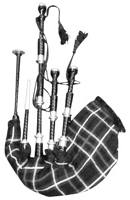
|
Even folk dancers who know that there are more kinds of bagpipes than the SCOTTISH BAGPIPE may not be aware of the wide distribution and importance that bagpipes have enjoyed in the past. Even today, in some areas, the bagpipe retains its traditional role as a provider of entertainment and dance music.
In North Africa and the Middle East, a bagpipe similar to the Turkish Tulum is often found playing for gatherings. In Italy, shepherds come down form the hills to cities at Christmastime and play the Zampogna to earn money. Bagpipes are also found in Bulgaria, Macedonia, France, and Ireland.
Though once played regularly as the predominant form of musical entertainment for people in the village, bagpipes are now heard primarily on the national radio, played as curiosities, or associated with groups that perform traditional dances.
Some types of bagpipes found in Central Europe up to the early 1800s are now gone forever. Our ideas of what they sounded like and how they were played are guesses (although probably good ones) based on bagpipes that survived in surrounding areas.
Soon after the bagpipe was introduced to Western Europe around 1000-1100 CE, it developed into a very important provider of musical entertainment. Bagpipes were found in an amazing variety of shapes and sizes as solo instruments and as a part of court orchestras. Drawings made in the early 16th century by Praetorius, one of the earliest sources of detailed information on musical instruments, show several kinds of bagpipes amidst the collections of recorders, crumhorns (a capped reed instrument similar to that of the chanter of a bagpipe), and other instruments of the time.
Unfortunately, as Western music became more complicated and sophisticated, the less versatile bagpipe lost its place in the orchestra and became more the instrument of the village people. Eventually, when they also found the bagpipe out of step with the times, it became extinct in some areas, and dated or passe in most others.
 What happened in Hungary is a good example of this phenomenon. In the 1600s, the HUNGARIAN DUDA was found in orchestras maintained by wealthy Hungarian land-owners for their entertainment. It played alongside such instruments as violins, trumpets, and cimbaloms. It was also used for military music, such as the Scottish bagpipe but on a smaller scale. During the 1700s, however, the increasing influx of Western music and instruments, especially from Germany, drove the bagpipe from the orchestra. At the beginning of the 1800s, there were still a few highly respected players of the bagpipe who would provide music for upper-crust dances, but gradually during that century people in the prosperous lowland areas lost interest in the bagpipe and it was retained only in the mountain areas. Around the turn of the century, it was still popular among the shepherds. I have seen a picture taken in 1910 of six shepherds, all wearing their heavily embroidered woolen cloaks and all holding beautifully carved and finished bagpipes.
What happened in Hungary is a good example of this phenomenon. In the 1600s, the HUNGARIAN DUDA was found in orchestras maintained by wealthy Hungarian land-owners for their entertainment. It played alongside such instruments as violins, trumpets, and cimbaloms. It was also used for military music, such as the Scottish bagpipe but on a smaller scale. During the 1700s, however, the increasing influx of Western music and instruments, especially from Germany, drove the bagpipe from the orchestra. At the beginning of the 1800s, there were still a few highly respected players of the bagpipe who would provide music for upper-crust dances, but gradually during that century people in the prosperous lowland areas lost interest in the bagpipe and it was retained only in the mountain areas. Around the turn of the century, it was still popular among the shepherds. I have seen a picture taken in 1910 of six shepherds, all wearing their heavily embroidered woolen cloaks and all holding beautifully carved and finished bagpipes.
The great exchange of people and ideas accompanying World War I cut the use of the Hungarian bagpipe still further. Often, men who went to serve in the army wojld be exposed to Western and popular music, and a few of them would return to the village with new ideas and new instruments. A brief resurgence of popularity of the bagpipe in the mountain regions occurred after the war because of widespread poverty, but, one by one, makers and players of the instrument died without passing on their art. I believe the last of the bagpipe players died in the 1960s. Apparently, the bagpipe is no longer played in Hungary, even in performing groups. Perhaps if the current interest in "genuine" dances and music continues, the bagpipe will be revived in Hungarian performing groups, at least as an interesting curiosity.
Some musicologists and amateur psychiatrists have suggested that the drone of a bagpipe has a hypnotizing effect that accounts for its fascination. Perhaps this is why I enjoy building these instruments. Or perhaps it is nostalgia, or simply the satisfaction of making something both entertaining and unusual.
TURKISH TULUM
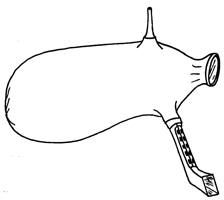 The Turkish Tulum is of a very ancient type and is similar to bagpipes found in North Africa, Greece, and many Middle Eastern countries. The chanter is made with two identical pipes of cane with five holes and each set in a carved wooden holder. The bell at the end is either an animal horn or is carved as part of the wooden holder. The player's fingers cover adjacent holes and the two pipes usually sound the same note simultaneously. Sometimes, however, the player uncovers only one hole of a pair, allowing certain harmonies to sound. Melodies can be surprisingly complex.
The Turkish Tulum is of a very ancient type and is similar to bagpipes found in North Africa, Greece, and many Middle Eastern countries. The chanter is made with two identical pipes of cane with five holes and each set in a carved wooden holder. The bell at the end is either an animal horn or is carved as part of the wooden holder. The player's fingers cover adjacent holes and the two pipes usually sound the same note simultaneously. Sometimes, however, the player uncovers only one hole of a pair, allowing certain harmonies to sound. Melodies can be surprisingly complex.
The blowpipe and the wooden pipe holder are tied directly into the bag, which is usually a crudely cured goatskin. Sometimes a decorated mirror is tied into the neck opening.
CROATIAN MIH
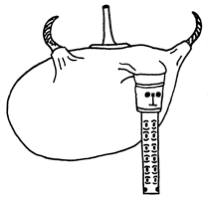 The Croatian Mih, which is found on and near the Adriatic coast of the Balkans, is the next step up from the Turkish Tulum. It also has two side by side pipes, with adjacent holes covered by the same finger, but here the pipes are bored in a flattish piece of wood that is fitted into a carved neck stock. The blowpipe is fitted into a wooden disk tied into the bag in such a position that the horns tied into the leg openings of the goatskin are pointed forward.
The Croatian Mih, which is found on and near the Adriatic coast of the Balkans, is the next step up from the Turkish Tulum. It also has two side by side pipes, with adjacent holes covered by the same finger, but here the pipes are bored in a flattish piece of wood that is fitted into a carved neck stock. The blowpipe is fitted into a wooden disk tied into the bag in such a position that the horns tied into the leg openings of the goatskin are pointed forward.
Some of these bagpipes have six identical finger holes in each pipe, but others have various combinations of holes, such as six in one and two in the other. These hole patterns give harmonies characteristic of individual areas.
SERBIAN GAJDA
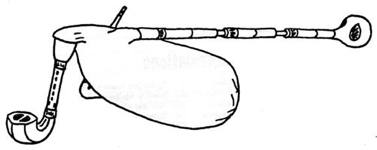 The Serbian Gajda is part of a family of bagpipes found in Northern Yugoslavia, Hungary, and the Ukraine. The chanter has two side by side bores, each with a single-bladed reed. The melody is played on one bore that has five finger holes. The other bore has a single finger hole near the bottom. When this hole is open, it plays the same note as the lowest one on the melody side. When it is closed, a harmony note sounds and is amplified in the carved wooden bell at the bottom of the chamber.
The Serbian Gajda is part of a family of bagpipes found in Northern Yugoslavia, Hungary, and the Ukraine. The chanter has two side by side bores, each with a single-bladed reed. The melody is played on one bore that has five finger holes. The other bore has a single finger hole near the bottom. When this hole is open, it plays the same note as the lowest one on the melody side. When it is closed, a harmony note sounds and is amplified in the carved wooden bell at the bottom of the chamber.
The melodies played on the five-hole bore are usually not too complicated, but the addition of the rhythm and harmony effects of the alternating note of the counter-drone gives a full sound. The large bass drone usually has a gourd at the end to amplify its sound.
BANAT GAJDA
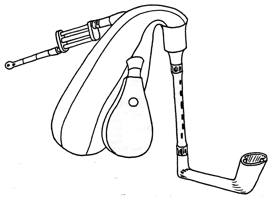 The Banat Gajda is melodically identical to the Serbian Gajda. It is usually, however, much larger and lower pitched. Often, the pipe length of the bass drone must be so great to play the correct note that it is constructed with three wooden tubes side by side and interconnected to form a "folded" pipe. This cuts the overall length considerably.
The Banat Gajda is melodically identical to the Serbian Gajda. It is usually, however, much larger and lower pitched. Often, the pipe length of the bass drone must be so great to play the correct note that it is constructed with three wooden tubes side by side and interconnected to form a "folded" pipe. This cuts the overall length considerably.
These bagpipes are often played using bellows for an air supply, which makes singing along much easier for the player. It is interesting to note that a player of this bagpipe can produce the three parts usually associated with Croatian and Slavonian songs. He sings the melody, plays the harmony on the five-finger-hole bore, and the bass part on the alternating drone. This makes me think that these three-part songs are based on the music of this type bagpipe.
MACEDONIAN GAJDA
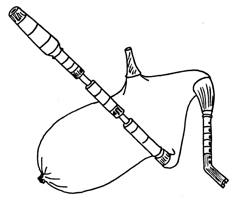 The Macedonian Gajda is heard frequently in folk dance circles. Many Macedonian dances are done that use recorded music featuring solo Gajda or Gajda in ensemble with other Macedonian folk instruments.
The Macedonian Gajda is heard frequently in folk dance circles. Many Macedonian dances are done that use recorded music featuring solo Gajda or Gajda in ensemble with other Macedonian folk instruments.
The chanter has a small tube (the "fleahole") extending into the bore, located where the top finger hole would be. Uncovering this tube noises the pitch of some holes below by about a half-note, which allows playing in keys outside the major scale of the instrument, and is handy for trilling.
Another feature is that the drone is tuned to the middle of the chanter instead of near the bottom as is common on most bagpipes. Commonly, both major and minor scales are included in the same tone and the lower notes of the chanter are used to give various harmonies with the drone. All in all, a very interesting instrument.
BULGARIAN GAJDA
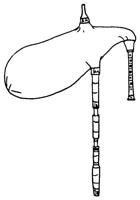 The Bulgarian Gajda is very similar to the Macedonian Gajda in construction, sharing the "fleahole" and drone tuning. The most obvious difference is that the bottom of the chanter lacks the angled horn "bell" of the Macedonian chanter. Also, the bore of the Bulgarian chanter is usually somewhat conical (the Macedonian's is cylindrical) which gives it a brighter, louder tone.
The Bulgarian Gajda is very similar to the Macedonian Gajda in construction, sharing the "fleahole" and drone tuning. The most obvious difference is that the bottom of the chanter lacks the angled horn "bell" of the Macedonian chanter. Also, the bore of the Bulgarian chanter is usually somewhat conical (the Macedonian's is cylindrical) which gives it a brighter, louder tone.
The playing technique of the best Bulgarian Gajda players is very highly developed. The melodic possibilities of the chanter are exploited to the fullest, and the accenting, using trills, blipped high notes, and harmony effects with lower notes is amazingly complicated.
RHODOPE KABA GAJDA
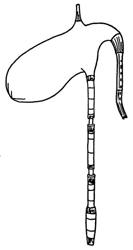 The Rhodope Kaba Gajda has the same features as the Bulgarian Gajda, but is much lower pitched, sometimes a whole octave below the smaller Bulgarian one. The drone is a very long, almost touching the ground as it hangs down from the bag. The sound of the drone is loud, rich, and full. The chanter is mellow, having a small cylindrical bore.
The Rhodope Kaba Gajda has the same features as the Bulgarian Gajda, but is much lower pitched, sometimes a whole octave below the smaller Bulgarian one. The drone is a very long, almost touching the ground as it hangs down from the bag. The sound of the drone is loud, rich, and full. The chanter is mellow, having a small cylindrical bore.
Unlike most Gajdas, this bagpipe is often played in groups. There is an annual meeting in the Rhodope mountains of Bulgaria where around one hundred of the bagpipes play together.
Another difference is that, at least until recent times, the Rhodope Gajda was played mainly to accompany songs, dance tunes being of lesser importance. This is probably why this fine and full-sounding bagpipe is not heard much in folk-dance circles.
FRENCH CORNAMUSE
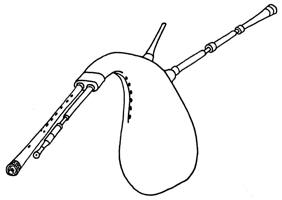 The French Cornamuse is still played in Central France, but mainly in organized groups including hurdy-gurdys, violins, and sometimes accordions.
The French Cornamuse is still played in Central France, but mainly in organized groups including hurdy-gurdys, violins, and sometimes accordions.
The distinguishing feature of the Cornamuse is the small tenor drone located alongside the chanter. The player's upper hand on the chanter goes around this drone. A bass drone is often included, but not always. The chanter has a narrow conical bore, and uses a double reed. The drones, however, use single-bladed reeds (like a primitive clarinet reed) such as are found in Eastern European bagpipes.
The bag is sewn our of a tanned leather, and often has a cloth cover of velvet. The workmanship on the best of these bagpipes is very fine, with decorative inlays of metal or ivory set in ebony pipes.
ITALIAN ZAMPOGNA
 The Italian Zampogna was played by traveling musicians all over Western Europe up until the early 1800s. Apparently, during the Middle Ages, bagpipes of this type with two separate chanters (one fingered with each hand) were quite common, but the Zampogna seems to be the only surviving example.
The Italian Zampogna was played by traveling musicians all over Western Europe up until the early 1800s. Apparently, during the Middle Ages, bagpipes of this type with two separate chanters (one fingered with each hand) were quite common, but the Zampogna seems to be the only surviving example.
It is also the only bagpipe to preserve the wide flaring bells on the chanters that were often found on Medieval bagpipes.
Another unique feature of this instrument is that both the chanters and the drones are equipped with "double" reeds, which are similar to oboe reeds. Many Western European bagpipes, including the Scottish bagpipe, have double reeds in the chanter, but none of the others have them in the drone.
Another form of this bagpipe exists that has the chanters tuned in octaves. It is made to be played with a shawm-like instrument (a primitive oboe) called the Ciamarella. In this case, the bagpipe player plays the harmony with one chanter and an alternating bass accompaniment with the other.
Drawings of the nine bagpipes by Richard Maheu, 1976.
First printed in the May 1976 issue Folk Dance Scene in Baton Rouge, a folk dance newspaper edited by Vonnie Brown.
It was then printed in the May and June 1977 issues of Mixed Pickles, a folk dance newspaper edited by Raymond LaBarbara.
DOCUMENTS
- Bagpipes, an article.
- Bagpipes of Hungary, an article.
- Who Invented the Bagpipe?, an article.
Used with permission of the author.
BAGPIPE PHOTOS
CLICK AN IMAGE TO ENLARGE
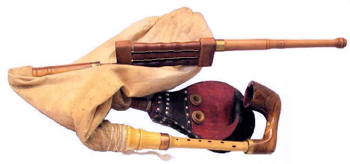
Banat Gajda |

Bulgarian Gajda |
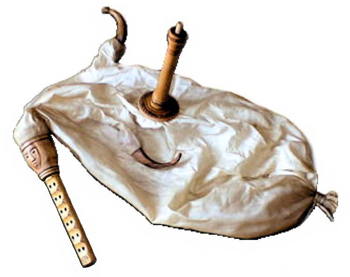
Croatian Mih |
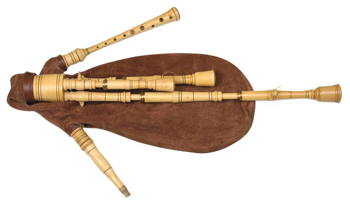
French Cornamuse |

Italian Zampogna |
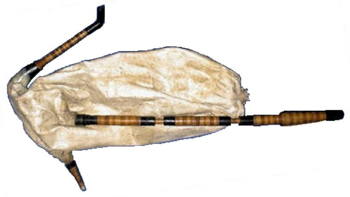
Macedonian Gajda |
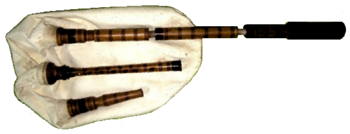
Rhodope Kaba Gajda |
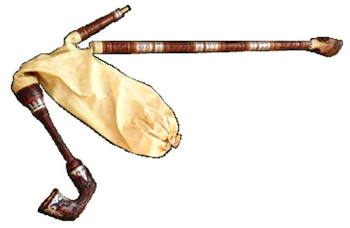
Serbian Gajda |

Turkish Tulum |

Hungarian Duda |

Scottish Bagpipe |
This page © 2018 by Ron Houston.
Please do not copy any part of this page without including this copyright notice.
Please do not copy small portions out of context.
Please do not copy large portions without permission from Ron Houston.